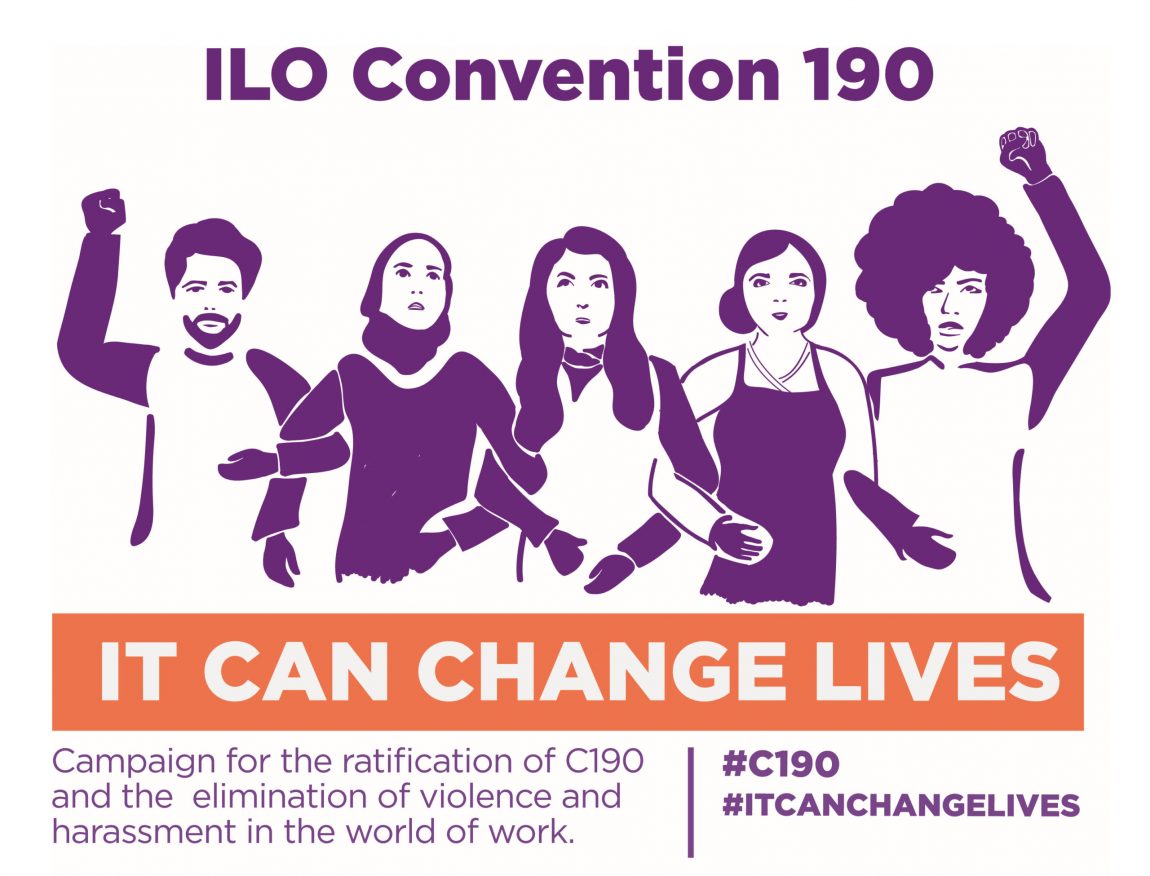
ILO Convention 190: the “new” basic human rights in the world of work
Introduction. As it is well known, the International Labour Organization has always been particularly sensitive with regard to the topic of violence against both women and men in the world of work.
The abovementioned international organization underlined that “violence and harassment in the world of work remains pervasive, affecting all countries, occupations and work arrangements. It manifests in different forms and contexts. It deprives people of their dignity and is incompatible with decent work and social justice”[1].
In addition, the entire global community has been more and more aware of the importance of facing and then eliminating violence and harassment in the world of work.
In particular, the 2030 Agenda for Sustainable Development Goals, adopted by the all United Member States in 2015, pointed out the importance of achieving “gender equality and empower all women and girls” (Goal 5)[2] and “promote sustained, inclusive and sustainable economic. Growth, full and productive employment and decent work for all” (Goal 8)[3].
As a consequence, on 21st June 2019 the ILO’s International Labour Conference adopted the C190 Violence and Harassment Convention[4] and the subsequent Recommendation n. 206[5].
As it will be enlightened further, the adoption of this international legal instrument is of paramount importance because, for the first time in the history of international law, principles aimed at ending violence and harassment in the world of work were enshrined in an international treaty.
Violence and harassment no. 190 ILO Convention. Prior to probing into the details of the aforementioned ILO n. 190 Convention, it will be explained which are the aims and purposes of the International Labour Organization, what is an international convention and in what it differs from the so-called recommendations.
The International Labour Organization is a UN agency formed by governments, employers and workers of 187 member States whose scope is to set international labour standards in order to promote and guarantee decent work for all women and men.
In order to establish new labour standards, the ILO International Labour Conference adopts international norms that are enshrined in Conventions and Recommendations.
With regard to the former, Conventions are international treaties that become legally binding once they are ratified by the State Parties.
With regard to the latter, Recommendations are non-binding legal instruments that are mainly focused on the labour standards set out in the related Conventions.
Considering that they serve as guidelines, national authorities can choose freely to comply them or not.
As previously mentioned, the C190 ILO Convention is considered of historical importance because it is the very first international treaty that condemns, without compromise, every form of violence and harassment in the world of work.
It is entirely focused on the right of every individual to work in an environment free from violence and harassment, including gender-based violence and harassment, because it constitutes a human rights violation and a threat to decent working conditions.
As known, the development of human rights law led to the adoption of a large number of international treaties[6] but never before was stated that violence and harassment in the world of work is: a human rights violation and abuse; a threat to equal opportunities in general and in the labour market; unacceptable and incompatible with decent work; a menace for a person’s psychological, physical and sexual health, dignity, family and social environment; a risk for both enterprises’ reputation and productivity.
Art. 1 of the ILO C190 Convention provides two definitions regarding the terms “violence and harassment” and “gender-based violence and harassment”.
The aforementioned Convention makes it clear that “violence and harassment in the world of work refers to a range of unacceptable behaviours and practices, or threats thereof, whether a single occurrence or repeated, that aim at, result in, or a likely to result in physical, psychological, sexual or economic harm, and includes gender-based violence and harassment”. From a deep reading of art. 1 of the C190 Convention, the following comes to light:
1) it is correct to talk of violence and harassment even if the “incorrect” behavior, practice or threat occurs only one single time (one-off event). It means that companies, managers, workers and trade unions cannot look the other way in any case. Once a violent and/or harassment related episode happens, it has to be addressed immediately and properly;
2) we are dealing with violence and harassment not only in case of threats but also when someone’s behave aims to undermine, humiliate, offend, injure and jeer at someone else. The threshold above which we find violence and harassment is quite low if we consider that it is not required that the perpetrator “achieves his/her goal” but aims to it;
3) as art. 1 of the ILO C190 Convention does not make distinctions: anyone can carry out or be subject to violence and harassment in the world of work (including third parties);
4) violence and harassment can affect physically (such as injuries…), psychologically (such as mobbing, bullying, undesired jokes, …), sexually (such as sexual harassment, rape, drop hints, showing pornographic materials…) and economically (such as blackmailing someone to have something done or undone…).
When it comes to the term “gender-based violence and harassment”, it means “violence and harassment directed at persons because of their sex or gender, or affecting persons of a particular sex or gender disproportionately, and includes sexual harassment”.
At this point, we shall explain why and how violence and harassment can be gendered.
Prior to answering the questions, the World Health Organization describes gender as “the characteristics of women and men that are socially constructed, while sex refers to those that are biologically determined”.
In particular, Jim Holmes of the WHO Organization expressed it quite clearly: “gender refers to the roles, behaviours, activities, attributes and opportunities that any society considers appropriate for girls and boys, and women and men. Gender interacts with, but is different from, the binary categories of biological sex”.
Considering that GB violence and harassment lies in gender and power inequality, it should be noticed that gender-based violence and harassment affects the workplace environment not only in the developing countries, but also in the most industrialized ones.
GB violence and harassment is perpetrated against people because they do not conform to the typical role that society attributes to them or that are considered natural and acceptable for them; in other words, if someone does not align with the socially accepted gender roles, it is more likely that he/she will be subject to this form of discrimination.
Consequently, GB violence and harassment is not a synonym for violence and harassment against women and girls. Men and boys can be victims too (as an example we could think to men that are perceived to be gay, bisexual or transgender, who choose a “traditionally female job”, who decide to take parental leave and so on).
In particular, the Committee on the Elimination of Discrimination against Women (CEDAW) in its General Recommendation n. 19 defined GB violence (and harassment) as “violence that is directed against a woman because she is a woman or that affects women disproportionately”, including “acts that inflict physical, mental or sexual harm or suffering, threats of such acts, coercion and other deprivations of liberty”.
We shall provide some examples in which it is likely that gender-based violence and harassment occur: at the psychological level: psychologically abusive behaviours include, inter alia, undue controlling, blackmailing, stalking, rejection for having children to take care of, not granting maternal leave or paid maternal leave, not allowing breastfeeding breaks; at the physical level: physically abusive behaviours include, among other things, beating, injuring, pushing, pulling hair, using weapons or means of correction; at the sexual level: sexually abusive behaviours include, by the way, raping or attempting to rape, sexual jokes, sexual allusions, verbal or non-verbal conducts of sexual nature, showing pornographic materials.
The C190 Convention is aimed at prohibiting violence and harassment in the world of work, including GB violence and harassment, because it undermines the dignity of every individual and it affects both the companies and their production negatively [7].
As the scope of this ILO Convention is to eradicate violence and harassment, including GB violence and harassment, from the work environment and protect all the workers, we shall know who a worker is and what is meant with world of work.
With regard to “the workers and other people in the world of work”, art. 2 of the ILO C190 Convention includes employees according to the national law, all persons working irrespective of their contractual status, people in training (such as interns and apprentices), workers whose contract or employment has been terminated, job seekers, applicants, volunteers and those who are in charge of exercising the authority, duties or responsibilities of an employer.
In addition, art. 2.2. of the aforementioned Convention specifies that it applies to all sectors[8].
The provided definition of “worker” can be considered revolutionary because it includes all the persons who are directly or indirectly part or linked to the world of work.
In other words, the definition of worker provided by the ILO C190 Convention is so very broad because it is aimed at protecting the most vulnerable and precarious workers.
When it comes to the definition of “world of work”, the ILO C190 Convention puts forwards the notion in order to assure the most extensive protection to all the workers.
Art. 3 of the abovementioned Convention provides a broad definition of world of work, as it includes: the traditional notion of workplace, including both private and public spaces where they are a place of work; all places where the worker is paid, rests, eats, uses sanitary, washes and changes; work-related trips, travels, trainings, events or social activities; work-related communications, including those enabled by information and communication technologies; employer-provided accommodation; commuting to and from work.
The broad definition provided ensures a comprehensive protection of workers because it makes clear that there is no space for violence and harassment neither in the traditional physical workplace nor in the work-related spaces and activities. In other words, the world of work includes all the places accessible to a worker, all the events where his/her presence is required or voluntary, all the activities related with his/her working life and the time and means of transportation to go or to commute to work.
The new definition provided of world of work goes beyond the national legal frameworks that are way more formal. The prospective changes because we pass from the traditional “workplace” to the “world of work”: the ILO C190 Convention takes into consideration the fact that the future of work will be more flexible than what we have been used until the present days.
It seems correct to affirm that the way we are used to work, including space, time, employment relationships and contracts, will be redefined; in the light of these considerations, national lawmakers should be prepared to address the challenge, rethinking the traditional labour law categories and the forms of protection provided.
From the given definition of “world of work”, it seems possible to affirm that it broadens the definition of work in terms of its duration as it includes the time needed to eat, rest and commute.
The impact of the ILO C190 Convention on workers’ labour conditions. We shall consider the impact that the ILO C190 Convention shall have in case of ratification. Art. 14 of the ILO C190 Convention states that the “Convention shall be binding only upon those Members of the International Labour Organizations whose ratifications have been registered with the Director-General of the International Labour Office”.
In particular, it comes into force twelve months after the date on which the ratifications of two Member States have been registered.
Prior to ratifying the ILO C190 Convention, Member States have to assess if their domestic (labour) laws and regulations comply with the objects and scopes set out in the Convention; otherwise, they shall “update” their legislation adopting new laws and regulations in order to: define the concept of “violence and harassment, including gender-based violence and harassment” (as single or separate concepts) (art. 7); adopt provisions where it is clearly established that violence and harassment, including gender-based violence and harassment, are prohibited in the world of work (art 7); take appropriate measures, along with employers’ and workers’ organizations, in order to identify the sectors and occupations that are more at risk and take effective measures to protect those persons (art. 8); adopt laws and regulations requiring employers to adopt workplace policies on violence and harassment and to evaluate and identify the hazards and the risks of violence and harassment, including GB violence and harassment, in the workplace in order to prevent and control it (art. 9); provide to workers the information and training regarding the risks of violence and harassment, the precautionary and protection measures, their rights and the responsibilities of the individuals who do not adopt the aforementioned workplace policy and who do not comply with the adopted laws and regulations on violence and harassment (art. 9)
Once that the abovementioned laws, regulations, policies and protection measures are introduced, the concerned Member State should monitor whether their application is properly enforced (art. 10).
Appropriate and effective remedies shall be ensured with the purpose of protecting all the workers who may report of cases of violence and harassment, including GB ones, in the workplace.
Finally, according to art. 10 of the C190 ILO Convention, Member States should ensure: complaint and investigation procedures in addition to dispute resolution mechanism at the workplace level in order to identify the problem and provide an effective and immediate response; investigation and resolution mechanisms at the courts or tribunals levels with appropriate and effective legal remedies; protection of the privacy of all the individuals involved and protection against the victimization and retaliation of complainants, victims, witnesses and the so-called whistle-blowers; legal, social medical and administrative support measures for complainants and victims; effective and proportionate sanctions in case of episodes of violence and harassment; the right of workers “to remove themselves from a work situation which they have reasonable justification to believe presents an imminent and serious danger to life, health or safety” due to violence and harassment without consequences.
Conclusion. In conclusion, the ILO no. 190 Convention has two main merits: foremost, it is the very first international human rights treaty that has addressed directly and comprehensively violence and harassment, including gender based violence and harassment, in the world of work; secondly, the new legal definitions provided, such as “worker” and “world of work”, are relevant because they take into consideration the new forms of work, including via digital technologies, which will need to be (furtherly) regulated by national lawmakers.
Footnotes:
[1] G. Ryder, Eliminating Violence and Harassment in the World of Work, Convention no. 190, Recommendation No. 206, and the accompanying Resolution, International Labour Organization, Geneva, 2019, pag. 1;
[2] With regard to the object and purpose of this work, Goal 5 of abovementioned 2030 Agenda expressed the importance of:
“5.1 End all forms of discrimination against all women and girls everywhere; 5.2 Eliminate all forms of violence against all women and girls in the public and private spheres, including trafficking and sexual and other types of exploitation; 5.5 Ensure women’s full and effective participation and equal opportunities for leadership at all levels of decision-making in political, economic and public life; 5.a Undertake reforms to give women equal rights to economic resources, as well as access to ownership and control over land and other forms of property, financial services, inheritance and natural resources, in accordance with national laws; 5.c Adopt and strengthen sound policies and enforceable legislation for the promotion of gender equality and the empowerment of all women and girls at all levels”;
[3] With regard to the object and purpose of this work, Goal 8 of the abovementioned 2030 Agenda expressed the importance of:
8.5 By 2030, achieve full and productive employment and decent work for all women and men, including for young people and persons with disabilities, and equal pay for work of equal value; 8.8 Protect labour rights and promote safe and secure working environments for all workers, including migrant workers, in particular women migrants, and those in precarious employment;
[4] The C190 Convention can be found at: https://www.ilo.org/dyn/normlex/en/f?p=NORMLEXPUB:12100:0::NO::P12100_ILO_CODE:C190;
[5] The Recommendation n. 206 related to the ILO C190 Convention can be found at https://www.ilo.org/dyn/normlex/en/f?p=NORMLEXPUB:12100:0::NO::P12100_ILO_CODE:R206;
[6] The most relevant international treaties where dignity, health and equal opportunities for every individual were affirmed are:
the ILO Declaration of Philadelphia: (II) “all human beings, irrespective of race, creed or sex, have the right to purse both their material well-being and their spiritual development in conditions of freedom and dignity, of economic security and equal opportunity”;
23 of the Universal Declaration of Human Rights: “(1) everyone has the right to work, to free choice of employment, to just and favourable conditions of work and to protection against unemployment; (2) everyone, without any discrimination, has the right to equal pay for equal work; (3) everyone who works has the right to just and favourable remuneration ensuring for himself and his family an existence worthy of human dignity and supplemented, if necessary, by other means of social protection; (4) everyone has the right to form and to join trade unions for the protection of his interests. Art. 24: “everyone has the right to rest and leisure, including reasonable limitation of working hours and periodic holidays with pay”;
8.3 (a) of the International Covenant on Civil and Political Rights: “no one shall be required to perform forced or compulsory labour”. Art. 22. 1: “everyone shall have the right to freedom of association with others, including the right to form and join trade unions for the protection of his interest”;
7 of the International Covenant on Economic, Social and Cultural Rights recognizes: “(b) safe and healthy working conditions; (c) equal opportunity for everyone to be promoted in his employment to an appropriate higher level, subject to no considerations other than those of seniority and competence;
5 of the International Convention on the Elimination of All Forms of Racial Discrimination recognizes: (i) the rights to work, to free choice of employment, to just and favourable conditions of work, to protection against unemployment, to equal pay for equal work, to just and favourable remuneration; (ii) the right to form and join trade unions;
6 of the Convention on the Elimination of All Forms of Discrimination against Women establishes: “State Parties shall take all appropriate measures to eliminate discrimination against women in the field of employment in order to ensure, on a basis of equality of men and women, the same rights (…)”. Despite the following rights, there is no reference to violence and harassment in the world of work;
The International Convention on the Protection of the Rights of All Migrant Workers and Members of Their Families is an international treaty that is aimed to a comprehensive protection of migrant workers but it does prohibit specifically violence and harassment in the world of work;
27 of the Convention of the Rights of Persons with Disabilities safeguard broadly the right of work of the aforementioned persons even if it does not contain any reference to violence and harassment in the world of work; nonetheless, it is to say that art. 16 of the Convention prohibits “all forms of exploitation, violence and abuse, including their gender-based aspects”. The importance of this statement is certain; although, it is not specifically related to the work environment;
[7] In case of interest of the impact of violence and harassment, including GB violence and harassment, in the world of work, please read: Ending violence and harassment against women and men in the world of work, report V (1), International Labour Conference, 107th Session 2018, pag 26, available at https://www.ilo.org/wcmsp5/groups/public/—ed_norm/—relconf/documents/meetingdocument/wcms_553577.pdf ;
[8] Art. 2.2. of the ILO C190 Convention establishes that it “applies to all sectors, whether private or public, both in the formal and informal economy, and whether in urban or rural areas”.
Salvis Juribus – Rivista di informazione giuridica
Direttore responsabile Avv. Giacomo Romano
Listed in ROAD, con patrocinio UNESCO
Copyrights © 2015 - ISSN 2464-9775
Ufficio Redazione: redazione@salvisjuribus.it
Ufficio Risorse Umane: recruitment@salvisjuribus.it
Ufficio Commerciale: info@salvisjuribus.it
***
Metti una stella e seguici anche su Google News
The following two tabs change content below.
Gemma Giammattei
Laureata in Giurisprudenza con lode presso l'Università Cattolica del Sacro Cuore di Milano. Abilitata all'esercizio della professione forense dall'ottobre 2021, collabora con lo Studio Legale Giammattei.







